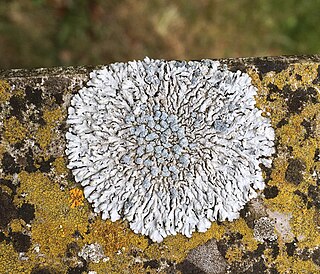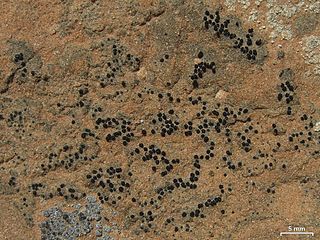
Anaptychia is a genus of lichen-forming fungi in the family Physciaceae. Anaptychia species have brown, thin-walled spores with a single septum, and a prosoplechtenchymatous upper cortex.

Physconia is a genus of lichen-forming fungi in the family Physciaceae. It has about 25 species. The genus was circumscribed by Czech lichenologist Josef Poelt in 1965, with Physconia pulverulenta assigned as the type species.

Diploicia canescens is a widespread species of lichenized fungus. It is found throughout much of the world, occurring on every continent except Antarctica.

Physcia caesia, known colloquially as blue-gray rosette lichen and powder-back lichen, is a species of foliose lichenized fungus. First described by Georg Franz Hoffmann in 1784, it is common across much of Europe, North America and New Zealand, and more patchily distributed in South America, Asia, Australia and Antarctica. There are 2 subspecies: P. c. caesia and P. c. ventosa, as well as a number of distinct forms and varieties. Molecular studies suggest that the species as currently defined may be polyphyletic. It is typically pale gray shading to darker gray in the center, and grows in a small rosette, usually some 2–3 cm (0.79–1.18 in) across at maturity. It only rarely has apothecia, instead reproducing most often vegetatively via soredia, which are piled in round blue-gray mounds across the thallus's upper surface. It grows most often on rock—principally calcareous, but also basaltic and siliceous—and also occurs on bone, bark and soil. It is nitrophilic and is particularly common on substrates where birds perch.

Protoparmelia badia is a species of crustose lichen in the family Parmeliaceae. It is a widely distributed, common species that grows on rocks.
Physconia jacutica is a species of saxicolous (rock-dwelling), foliose lichen in the family Physciaceae. It is found in the Russian Far East.
Lecania sessilisoraliata is a species of saxicolous (rock-dwelling), crustose lichen in the family Ramalinaceae. It is found on rock outcrops in the mountainous Burdur region of Turkey.

Psora taurensis is a species of terricolous (ground-dwelling), squamulose lichen in the family Lecanoraceae. It is found in the Taurus Mountains of Turkey.
Heteroplacidium zamenhofianum is a species of lichenicolous (lichen-eating) lichen in the family Verrucariaceae. As a juvenile, it is parasitic on some members of the lichen genus Staurothele, but later becomes independent and develops a brown, crustose thallus. Characteristic features of the lichen include its dark brown, somewhat squamulous thallus and relatively small ascospores. It is widely distributed in Europe and North America.
Lepraria granulata is a species of crustose and leprose lichen in the family Stereocaulaceae. It is found in mountainous locations of Eastern and Central Europe, where it usually grows over moss.

Bacidina pycnidiata is a species of crustose lichen in the family Ramalinaceae. It is widely distributed in Europe and North Asia. It is characterised by its whitish or cream-coloured pycnidia with long and ostiolar necks.
Dibaeis yurii is a little-known species of terricolous (ground-dwelling) lichen in the family Icmadophilaceae. It is found in the Russian Far East and in South Korea.
Gallowayella aphrodites is a species of corticolous (bark-dwelling), foliose (leafy) lichen in the family Teloschistaceae. It is found in the Mediterranean countries Greece, Cyprus, and Italy. Characteristics of the lichen include its small thallus, the disposition of the rhizines on the thallus undersurface, and the lack of vegetative propagules.
Atla oulankaensis is a rare species of saxicolous (rock-dwelling) lichen in the family Verrucariaceae. It has been recorded in Finland and in the Canadian arctic, growing on calciferous rock and on high-pH soil.

Staurothele elenkinii is a species of saxicolous (rock-dwelling) lichen in the family Verrucariaceae. It was described as new to science by Ukrainian lichenologist Alfred Oxner in 1927, from the steppes of Ukraine. In 2013 it was recorded from the northeast Caucasus, in Russia. It is also widespread on dry rocks in the North American west, ranging from the Northwest Territories south to the southwestern United States. It grows on shales, sandstones, and calcareous rocks.
Verrucaria oulankaensis is a rare species of saxicolous (rock-dwelling) crustose lichen in the family Verrucariaceae. It is found in north-eastern Finland, where it occurs on calcareous rocks on river shores.
Verrucaria ahtii is a species of saxicolous (rock-dwelling) crustose lichen in the family Verrucariaceae. It is found in Finland, Lithuania, Russia, and Switzerland, where it occurs on calcareous pebbles.
Kashiwadia is a genus of lichen-forming fungi in the family Physciaceae. The genus was circumscribed in Sergey Kondratyuk, László Lőkös, and Jae-Seoun Hur in 2014 to contain the species Physcia orientalis, after molecular phylogenetic analysis showed that the taxon occupied an isolated phylogenetic position in the Physciaceae. An additional five species were added to the genus in 2021. The genus name honours Japanese lichenologist Hiroyuki Kashiwadani, who originally described the type species.

Lecidea tessellata is a species of saxicolous (rock-dwelling), crustose lichen in the family Lecideaceae. It was formally described as a species in 1819 by German botanist Heinrich Flörke. In northern North America, it is common and widely distributed, growing on non-calcareous rocks. It also occurs in Afghanistan, China, Nepal, Europe, and Russian Asia. In India, it has been recorded only from the alpine Western Himalayas at an altitude of 3,450 m (11,320 ft). Its southern distribution extends to James Ross Island, where it is locally common.
Calopadia saxicola is a species of saxicolous (rock-dwelling) crustose lichen in the family Pilocarpaceae. It is found on the rocky shores of southern Brazil, where it thrives in the shade of vegetated zones and grows directly on rocks away from other crustose lichens. The lichen was formally described as a new species in 2015. Calopadia saxicola stands out from its close relatives due to its well-defined thallus, reddish-brown disc, thicker hymenium, and smaller conidia.








